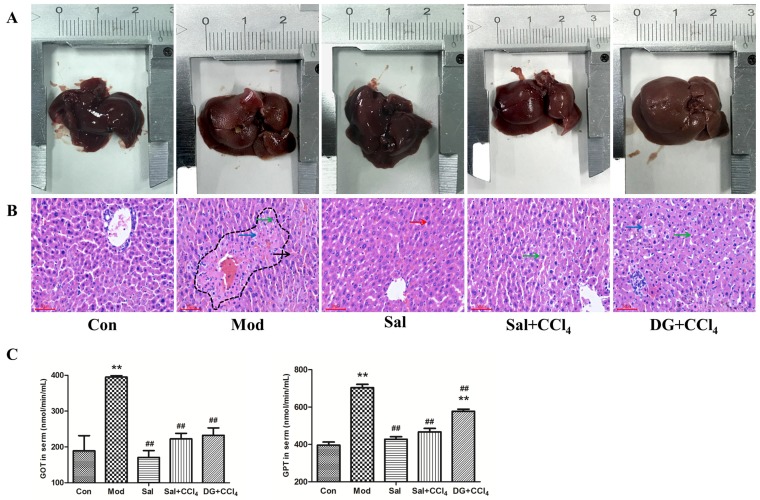Figure 2.
Salidroside attenuated carbon tetrachloride (CCl4)-induced liver steatosis and decreased hepatic transaminases in mice (n = 6). (A) Macroscopic characteristic of livers in control mice, model mice induced by CCl4, and mice treated with single salidroside, salidroside+CCl4, and diammonium glycyrrhizinate+CCl4 (Con, Mod, Sal, Sal+CCl4, and DG+CCl4, respectively). Livers in the Con and Sal groups had normal gross morphology. However, the livers of mice in Mod, Sal+CCl4, and DG+CCl4 groups showed increased volumes, decreased glossiness, and smoothness. The most severe and slightest lesions were observed in the Mod and the Sal+CCl4 groups, respectively. (B) Pathologic histology of livers in different groups. Mild steatosis can be observed in the liver of the Con group, and the Sal group showed a normal structure. Histopathological changes showed the fatty degeneration and necrosis of hepatocytes and infiltration of inflammatory cells, which were more and increasingly mild in the Mod, Sal+CCl4, and DG+CCl4 groups. Red arrows marked normal hepatocytes, green arrows marked cell nucleus pyknosis, black arrows marked cell nucleus broken, blue arrows marked vacuoles caused by steatosis, and dotted line denoted necrotic area. Magnification: 200×. (C) GOT and GPT activities in the serum of different groups. CCl4 treatment increased the serum GOT and GPT levels (p < 0.05). Salidroside reduced the CCl4-induced transaminase, and DG only alleviated GOT condition significantly (p < 0.05). The single-treatment of salidroside had no side-effect. p < 0.05 was considered statistically significant. **p < 0.05 (groups compared with the Con group) and ##p < 0.05 (groups compared with the Mod group). (GOT: glutamic oxalacetic transaminase; GPT: glutamic-pyruvic transaminase).

